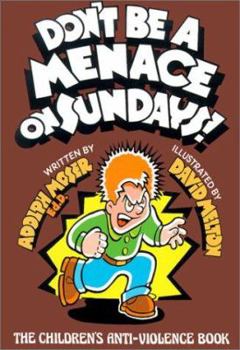Don't Be a Menace on Sundays!: The Children's Anti-Violence Book
Select Format
Select Condition 
Book Overview
DON'T BE A MENACE ON SUNDAYS! is the seventh book in the successful EMOTIONAL IMPACT SERIES. In this timely book, Dr. Adolph Moser discusses the kinds of violence that threaten the lives of children... This description may be from another edition of this product.
Format:Library Binding
Language:English
ISBN:0933849796
ISBN13:9780933849792
Release Date:January 2001
Publisher:Landmark Editions
Length:61 Pages
Weight:0.60 lbs.
Dimensions:0.4" x 6.2" x 9.0"
Age Range:9 to 12 years
Grade Range:Grades 4 to 7
Customer Reviews
4 ratings
Very helpful
Published by Thriftbooks.com User , 16 years ago
Great book. It helps kids in violent situations and also helps to explain violence to those who are not.
Don't Be A Menace on Sunday!
Published by Thriftbooks.com User , 17 years ago
Excellent book for children and families dealing with anger-management and strong emotions. It's a great book children can read on their own, have it read to them as well as an excellent book for families to read together. A must have book and must have series!
My children loved it
Published by Thriftbooks.com User , 18 years ago
My children found the book helpful and enjoyed reading it. The children have used the book to help them develop their skills, and have read the book over again on their own. I have been pleased with the Moser series as it is an easy read book for children. Children can understand the concepts and apply them to their every day life. The kids gave the rating.
Great
Published by Thriftbooks.com User , 22 years ago
This 60-page picture book contains simple language easily read by first and second graders (on a par with Dr. Suess), to teach children why people are violent, and how they can avoid trouble. It is best suited for children up to about 10 or 11.Much as we might like to, it's a mistake to teach children that no one ever hurts others, and Moser doesn't try. He starts by telling kids the truth--every day someone hits, kicks or shoots someone.Why do people behave so violently? Sometimes, they do so because they want things that belong to others, or want to tell them what to do. Sometimes they are so angry they can't control themselves or they want attention. Sometimes they have seen too much violence on TV, in movies or in video games, which can all make violence look and sound exciting. Children may think, "Wow, those things look like fun." They want to drive fast cars and smash them, learn how to fight and knock people down or get a gun and shoot it. They may even want to learn to make bombs and blow up buildings. This book, published in 2001, may well have been written after September 11. The simple illustrations definitely suggest the terrible pain of that trauma, albeit in as non-threatening a way as possible. The story also explains that while it may be fun to watch people do violent things in movies, games and on TV, they are pretend. When the shows and games end, the actors go home. But in real life, it is not fun to be threatened. People can be hurt by violence. They can really die. It's not fun to be in a car wreck, knocked around by a school yard bully or to have a gun aimed at you. Getting shot is not fun. Violence is not new to the world, Moser explains. For thousands of years, people fought, using their fists, and their teeth, and later on, rocks, clubs, knives, spears, bows and arrows and finally guns. None of these things are good or bad, the author explains. "They are simply tools." Guns and spears, bows and arrows can be good for hunting and knives may be used to cut meat and vegetables. But sometimes people use tools as weapons. Robbers carry guns to steal from others, and sometimes kill. People who do these things are a menace to themselves and others. Why would anyone want to be a menace? They shoot and kill other people, hurting the friends and families of their victims. Sometimes their victims are little children.About 2/3 through, the author turns to 10 methods kids can use to deal with these problems. Some will help children shape their own attitudes towards violent individuals who can hurt themselves and others. Others concern how kids should consider violent games and TV and things they can do instead of watching or playing such things. The tools offered here are sensible and should help children understand the dangers around them, how they can react responsibly to others' violent actions and how they might channel their own anger. Alyssa A. Lappen





